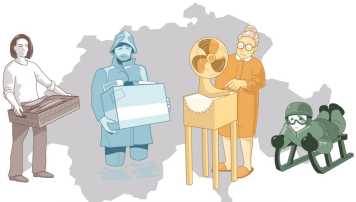C2SM Newsletter vol. 34

Modelling Activities and Services
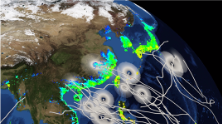
Working Group 1 (WG 1): High Performance Computing
The lightning potential index is a parameterisation in the ICON model that predicts the lightning activity in thunderstorms. As part of WG1 the code for its calculation was successfully modified in a way that it can be run on graphics processing units (GPU). Running code on GPU can significantly speed up the run time.
Working Group 2 (WG 2): Development of Weather and Climate Models
The C2SM core team investigated the potential of using nested domains for climate simulations using the ICON model with ECHAM physics. While we were able to technically run a couple of test cases using nested domains, the results did not make sense physically. Since ECHAM is not supported anymore at Max Planck Institute, and nesting in ICON with ECHAM physics is not used by any other group within the ICON community, further investigation including bug fixes would potentially imply a significant effort for C2SM with uncertain outcome. Based on these drawbacks, the involved group and we decided to not further investigate in this task.
Working Group 3 (WG 3): Climate Scenarios
As part of the preparation of EURO-CORDEX simulations with ICON-CLM, the C2SM core team has adapted a processing chain tool developed by the CLM community. It is known as the “Starter Package for ICON-CLM Experiments” (SPICE). It has been modified to run on Piz Daint, as it was previously only available on the German HPC clusters. Necessary input data (ERAinterim and ERA5) to drive the climate runs can be downloaded directly from DKRZ. SPICE is now available for all C2SM members via GitHub.
The Extreme scale computing and data platform for cloud-resolving weather and climate modeling (EXCLAIM) project aims to develop an ICON-model based infrastructure that is capable of running kilometre-scale climate simulations at both regional and global scales.
We are happy to welcome new team members aboard. Dr. Oliver Fuhrer, head of numerical weather prediction division at MeteoSwiss, joined the EXCLAIM executive committee that steers the strategic direction of the project. Dr. Brigitta Goger and Dr. Jacopo Canton, both postdoctoral researchers, just started working in close collaboration with Dr. Anurag Dipankar on the improvement of atmospheric turbulence modeling over complex topography and on urban modeling, resp. Our newest team member, Péter Kardos, joined the EXCLAIM software development team and will focus on the development of GT4Py (Gridtools for Python).
You can learn more about EXCLAIM in the ETH annual report 2021, where it is featured as one of the research highlights of the year.
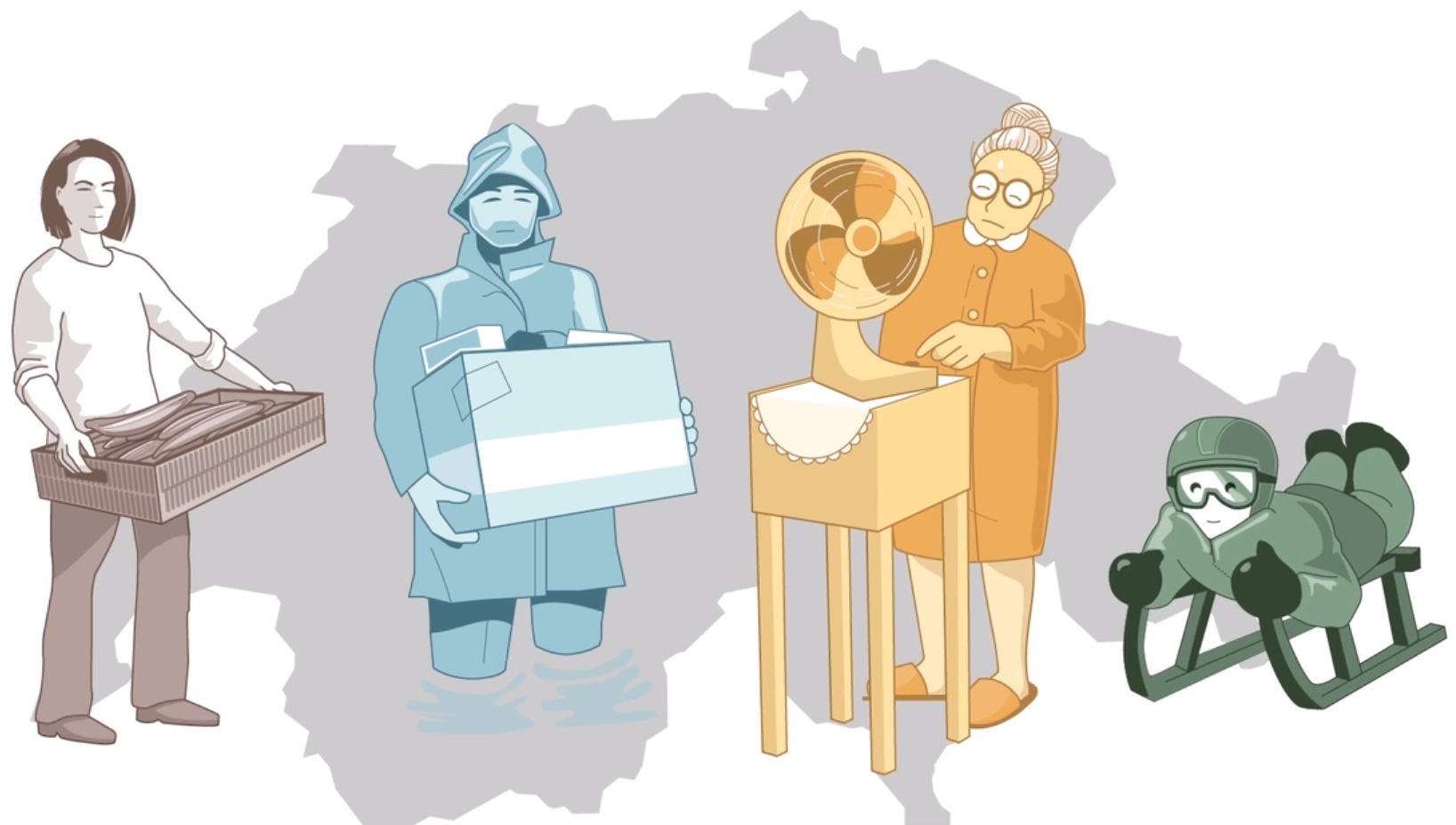
Climate Scenarios for Switzerland CH2018 – Approach and Implications
In late 2018, the CH2018 climate scenarios were officially released in form of six user-oriented products that originated from a joint effort between the Federal Office of Meteorology and Climatology MeteoSwiss, ETH Zurich and C2SM as a priority theme of the National Centre for Climate Services (NCCS). In this new article, the whole framework of the CH2018 project is presented and reflected. The framework encompasses the scientific approach, the way how users were integrated, how user-oriented products were streamlined, and how the project was organized. For a successful uptake of climate scenarios and in order to establish a true climate service, all these aspects jointly matter. Furthermore - with the CH2018 scenarios being in use for more than three years - important lessons learnt and user needs could be identified, which are also discussed in the article. These developments will shape the concept and planning of the next scenario generation in Switzerland.
Fischer et al. (2022). Climate Scenarios for Switzerland CH2018 – Approach and Implications. Climate Services, 26, 100288.
external pagehttps://doi.org/10.1016/j.cliser.2022.100288call_made
NCCS-Impacts programme: Public invitation to tender in early summer 2022

In the NCCS programme «Decision Support for Dealing with Climate Change in Switzerland: a cross-sectoral approach» («NCCS-Impacts»), actionable climate services for the environment, economy and society will be developed. Between 2022 and 2025, several cross-sectoral and interlinked projects will be implemented, addressing the following topics in the context of climate change: global impacts, ecosystem services, human health and animal health, costs of climate change, socio-economic scenarios, and critical energy infrastructures. For four of the projects, a public invitation to tender will be published in June 2022, which was announced earlier this month via external pagewww.simap.chcall_made. The C2SM partners ETH Zurich and WSL, as well as Agroscope and the Federal Food Safety and Veterinary Office (FSVO), are involved in the realisation of the projects with specific contributions. Note that, in their role as NCCS members or partners respectively, they are not allowed to participate in the open call for tender. More information on NCCS-Impacts is available online: external pagewww.nccs.admin.ch/impacts-encall_made
New European Green Deal project ICOS Cities to estimate urban CO2 emissions
Urban areas are responsible for about 70% of global fossil fuel emissions and are therefore at the heart of emission reduction efforts. The ICOS Cities project combines innovative measurement and modelling approaches to monitor greenhouse gas emissions from cities and develops unique tools and services in support of local climate action plans. Three pilot cities, Paris, Munich and Zurich have been selected to implement and evaluate the different approaches.
Empa coordinates the activities in the city of Zurich, which hosts a wealth of measurement technologies including street-level and roof-top CO2 sensor networks, eddy flux measurements, radiocarbon sampling, biospheric activity measurements, and new in-situ and remote sensing meteorological observations across the city. This unique measurement infrastructure will be complemented by a suite of atmospheric transport models ranging from building resolving Large-Eddy-Simulation to mesoscale models including ICON-ART, which will be operated by Empa for Paris and Zurich to quantify their CO2 emissions.
external pagehttps://www.icos-cp.eu/projects/icos-cities-projectcall_made
Newly funded NCCS-Project: Determining dynamic climate impacts on forest ecosystem services in managed Swiss forests
Swiss forests provide numerous ecosystem services important for human livelihoods. However, their long-term development is uncertain. To date, there is little information for forestry practitioners on necessary adaptations to management strategies considering the temporal development of forests under climate change. Identifying the right time to adapt, e.g. by planting new tree species or ending the current rotation as risks to existing stands become too high, is a key challenge. The new project links research and practice through dynamic forest modeling. Temporal trends of forest structure, composition and associated ecosystem services are assessed over a wide range of Swiss forest site types, taking into account extreme climate events and alternative management scenarios, using the models ForClim and LandClim. The project is funded by the external pageNCCScall_made for 3 years and is led by scientists from ETH Zurich and WSL, and it includes diverse forest stakeholders.
Towards an integrated understanding of climate impacts on seasonal tree development

Climate influences many processes in forest ecosystems. However, our understanding of how climate affects seasonal leaf development in combination with other environmental factors is limited. We also know little about whether changes in seasonal leaf development lead to altered tree growth which in turn could affect timber harvest volume. With an ETH Zurich research grant, Isabella Ostovary and Dr. Christof Bigler from the Forest Ecology group at the Department of Environmental Systems Science have now begun to investigate the combination of those factors and they will join data on climate, seasonal leaf development, forest structure, soil properties, topography and tree rings across Europe. Their interdisciplinary approach is expected to provide fresh insights into the influence of climate on seasonal tree development and tree growth.
More information about the project and group: http://www.forestecology.ethz.ch.
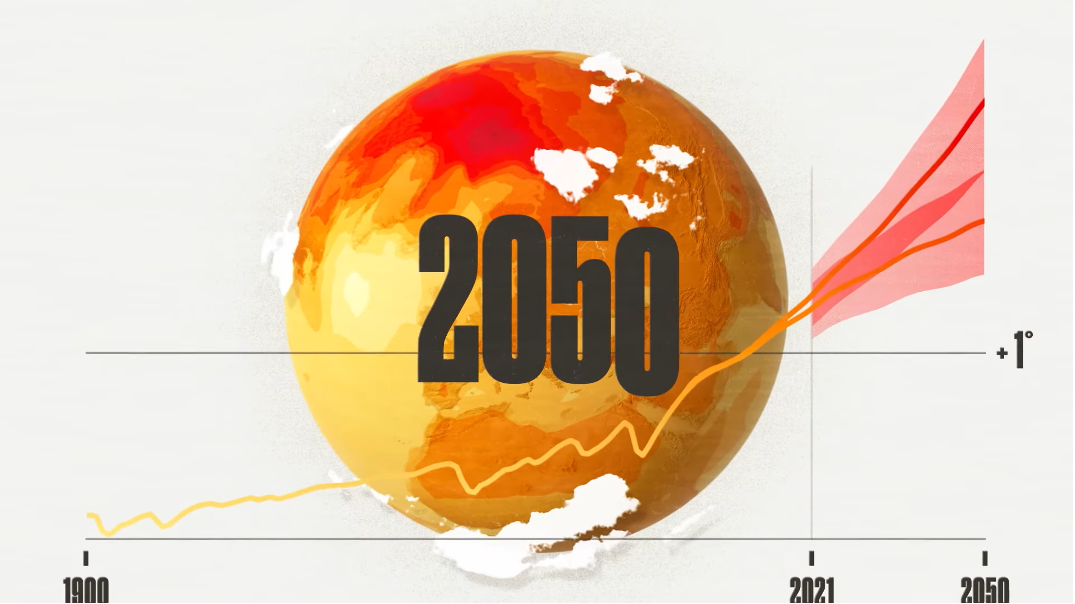
The speed and magnitude of the climate change we are facing today is unprecedented. Heatwaves, droughts, floods... We are feeling its effects on our daily lives, year after year. Its impacts will increase at least until 2050 and every region of Europe will be affected. Based on the results of the latest available studies and in particular on the Sixth IPCC Assessment Report, a team of scientists out of the European projects external pageEUCPcall_made and external pageEURO-CORDEXcall_made and under the lead of Météo France has now produced a movie that presents the climatic changes expected in Europe by 2050. Members of C2SM have also contributed. The movie explains in an accessible way the variations in temperature and precipitation as well as the extreme climate events that European inhabitants will have to face, in an accessible way. It thereby helps to understand how climate change will reshape our landscapes and lifestyles over the coming decades and enables us to better anticipate the need for human societies to adapt to these partly inevitable changes.
The movie is available in several languages:
external pagehttps://youtu.be/8CuqAN1z0Pkcall_made (German)
external pagehttps://youtu.be/n9Ej5E47TNIcall_made (English)
external pagehttps://youtu.be/64xNugjI6jccall_made (French)
external pagehttps://youtu.be/rfb-u2D-Y30call_made (Spanish)
external pagehttps://youtu.be/vUJ65VD47PAcall_made (Italian)
external pagehttps://youtu.be/cDoDktvzOXgcall_made (Croatian)
external pagehttps://youtu.be/x87yJrc4Oq4call_made (Swedish)
Climate scenarios for the indoor climate now available for building planning

Buildings constructed today will be exposed to climatic changes during their lifetime. The historical data currently used by building designers is now supplemented with data for the future based on the CH2018 Swiss Climate Scenarios. Hourly reference years representing the possible future climate are available at locations across Switzerland. In the case of four cities, the urban heat island effect is also considered.
As part of the external page“Climate-adapted construction – Foundations for the future”call_made project, supported by C2SM, this new basis to assess the indoor climate of the future was elaborated at MeteoSwiss. In a close exchange with practitioners, the data was compiled and iteratively tested in joint projects with the Lucerne University of Applied Sciences and Arts (HSLU), the Canton of Zurich Building Department, the Federal Office for the Environment (FOEN) and the Swiss Society of Engineers and Architects (SIA). This collaboration resulted in key recommendations for building designers on how to use the data correctly. Test simulations by HSLU provide initial insights into thermal comfort for various building types. The external pagenew datasetcall_made allows building designers to determine, for example, future energy requirements or to design building services, ensuring that buildings constructed today are also fit for the climate of tomorrow.
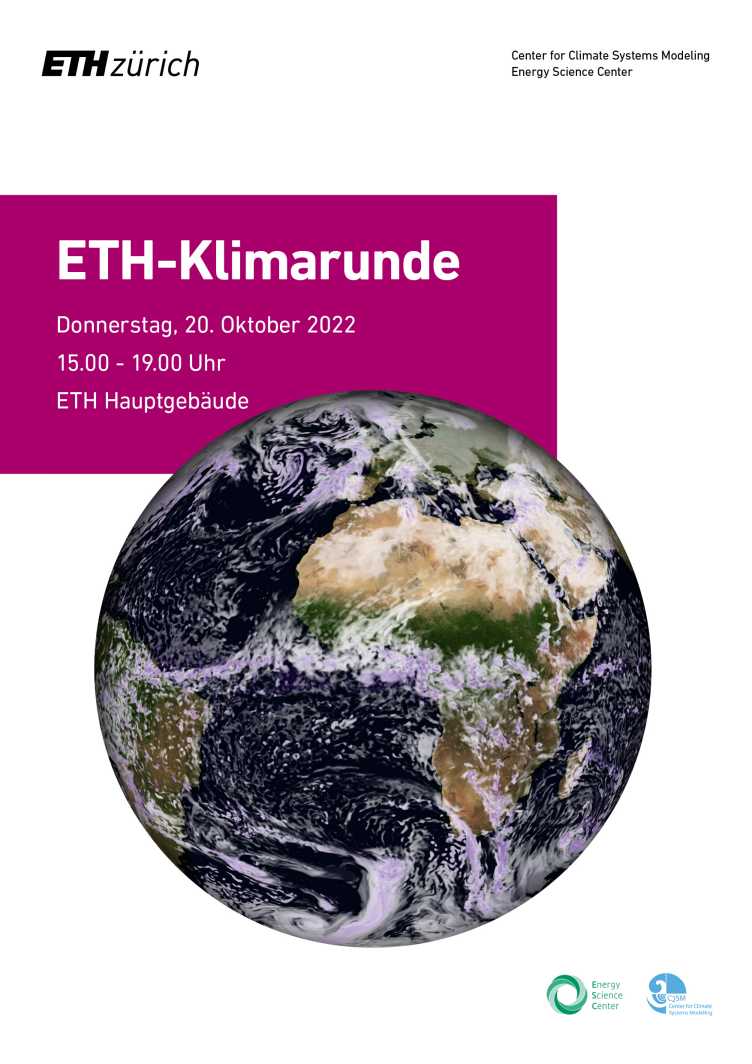
ETH-Klimarunde 2022
Wir freuen uns schon sehr, Sie dieses Jahr wieder persönlich über die neusten Erkenntnisse zum Klimawandel informieren zu dürfen. Wir diskutieren wie Wetterextreme mit dem Klimawandel zusammenhängen und was deren Folgen sind.
Die diesjährige Klimarunde findet am Donnerstag, dem 20. Oktober 2022 von 15.00 bis 19.00 Uhr im Hauptgebäude der ETH Zürich statt.
Halten Sie sich das Datum frei, und wir halten Sie auf dem Laufenden!
Tree Regeneration Modeling Workshop in Davos, 19-23 June
Much effort has been devoted to the modeling of the vegetation carbon balance arising from photosynthesis and respiration. However, less effort was spent on demographic processes, although they are pivotal for determining the response of the biosphere to climate change as well. A particularly under-represented field is the modeling of tree regeneration. An international workshop that focuses on the benchmarking of a wide range of vegetation models from the stand across the landsacpe to the global scale will be held in Davos from 19-23 June 2022. This is an activity funded by the COST Action PROCLIAS and ETH Zurich. It will bring together about 15 modeling teams, and the benchmarking of the models will be made against an unique dataset of long-term tree regeneration of 11 European species across a wide environmental gradient. The workshop outcome will be published in the peer-reviewed literature. Ultimately, this workshop will contribute to enhance the robustness and applicability of dynamic vegetation models to study global change effects. For more information, contact Harald Bugmann ().
Selected Press Articles

- Blick, external pageLovely frisst die Wiese nicht grünercall_made, Dr. Cyrill Brunner, 13.04.2022
- SRF 1, 10 vor 10, external pageWeltklimarat-Berichtcall_made, Prof. Anthony Patt, 04.04.2022
- RTS, external pageLa sécheresse en Europe s'accentue et affecte les écosystèmescall_made, Prof. Sonia Seneviratne, 02.04.2022
- Radio SRF 1 , Heute Morgen 08.00, external pageTemperaturrekord in der Antarktiscall_made, Prof. Reto Knutti, 23.03.2022
We congratulate our community members for their successfully completed PhDs!
- Fabienne Dahinden: Tropospheric moisture transport pathways and stable water isotopes over the subtropical North Atlantic. ETH Zürich, 04 Feb 2022.
Highlighted Papers from the C2SM Community
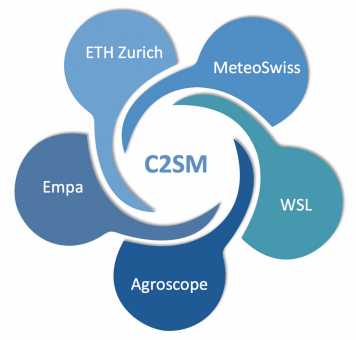
Safeguarding the energy transition against political backlash to carbon markets
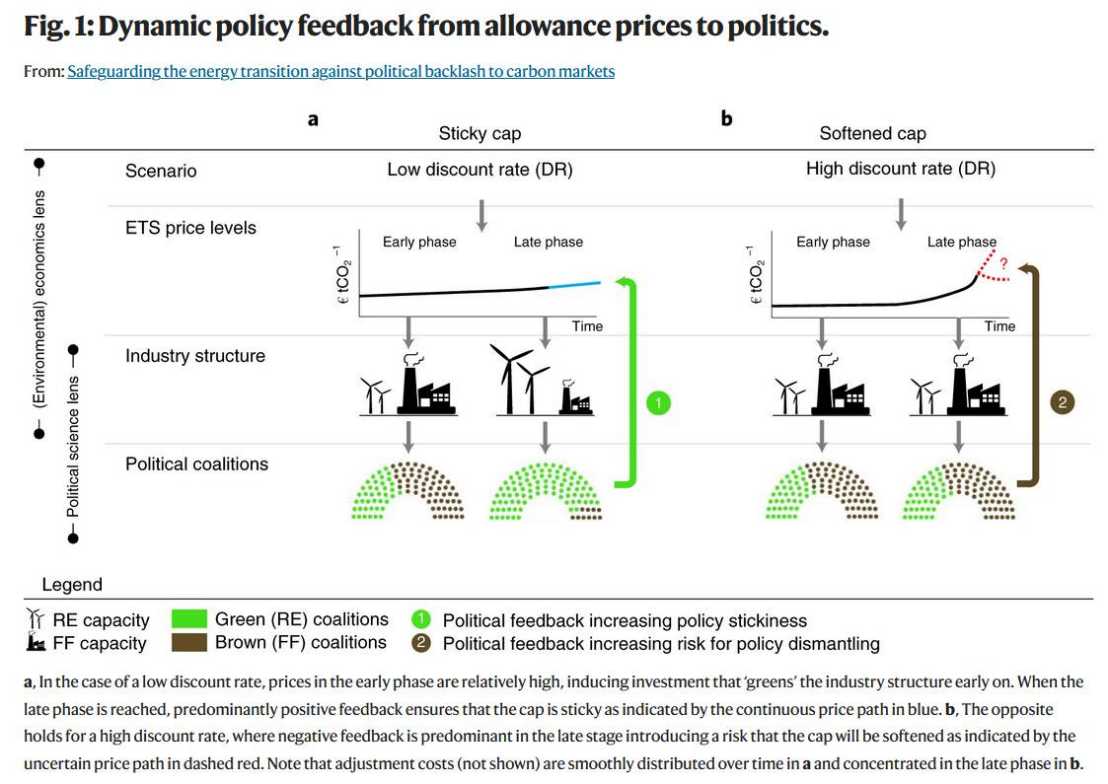
Substantial renewable energy (RE) cost reductions have raised the prospect of a subsidy-free RE era of the energy transition. The envisaged policy cornerstones of this era are carbon markets, which create economic incentives for sustaining further RE deployment. However, this overlooks that exposing RE to market risks and increasing interest rates would result in substantially higher financing cost, which in turn would lead to much steeper carbon price paths. The resulting political pressure may provoke a price-depressing regulatory intervention, disrupting further RE expansion. Here we conceptualize this feedback and infer indicators for the risk of such an intervention. By quantifying these indicators for the European Union, we find that increased financing cost could double carbon prices in the long term, halve the rate of renewable capacity deployment in the next 15 years and considerably increase the profits of fossil fuel plants. This implies a substantial risk of pushback that policymakers should safeguard against.
Pahle, M., Tietjen, O., Osorio, S., Egli, F., Steffen, B., Schmidt, T. S., & Edenhofer, O. (2022). Safeguarding the energy transition against political backlash to carbon markets. Nature Energy, (available online). external pagedoi.org/10.1038/s41560-022-00984-0call_made
Trends and drivers of recent summer drying in Switzerland
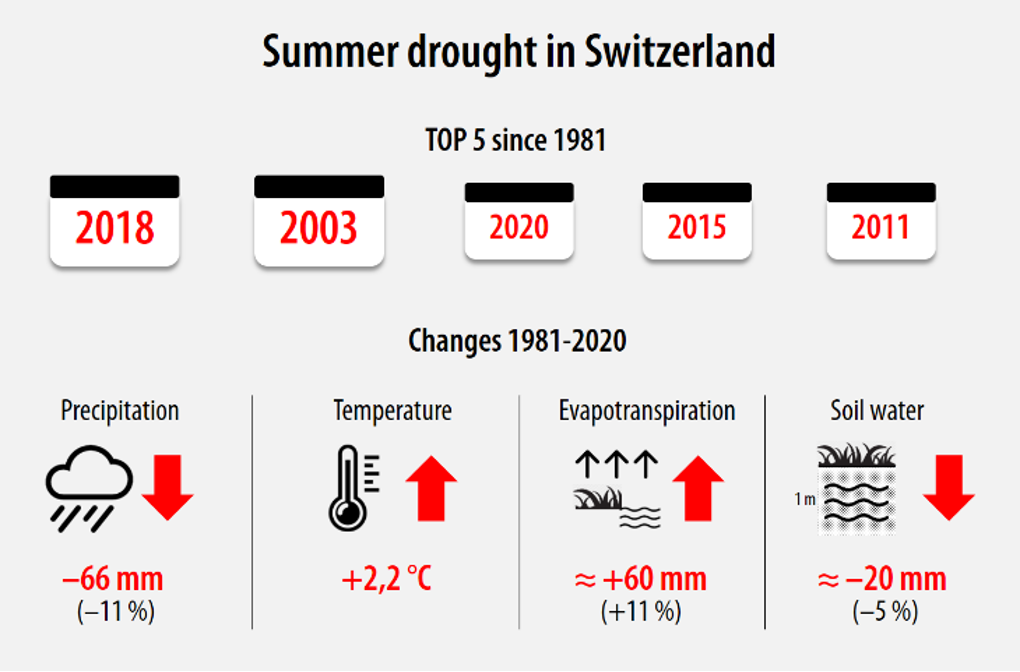
Drought indicators, evapotranspiration and meteorological data from point observations, reanalyses and regional climate model data have been analysed to assess trends and drivers of summer drought in Switzerland in the period 1981–2020. Indicators from station observations and reanalyses (ERA5 and ERA5-Land) show a clear tendency towards drier summer half-years with a drying in most months from March to October. Both, increasing evapotranspiration and a non-significant precipitation decrease are identified as important and roughly equivalent drivers. However, reanalyses show considerable differences for soil water and actual evapotranspiration, especially in drought summers. Variability and trends of the drought drivers temperature and precipitation are also investigated in the EURO-CORDEX regional climate model ensemble. Most simulations considerably underestimate the recent warming and the ensemble shows a large possible range of precipitation changes with a mean change near zero. The study highlights that the analysis of Central European summer drought evolution and its drivers remains challenging. A blog summarizing the results in German, French and Italian is available here: external pagebit.ly/3Cbdz7xcall_made
Scherrer, S.C., Hirschi, M., Spirig, C., Maurer, F. and Kotlarski, S. (2022). Trends and drivers of recent summer drying in Switzerland. Environ. Res. Commun., 4, 025004. external pagedoi: 10.1088/2515-7620/ac4fb9call_made
Using machine learning to identify foehn in a changing climate
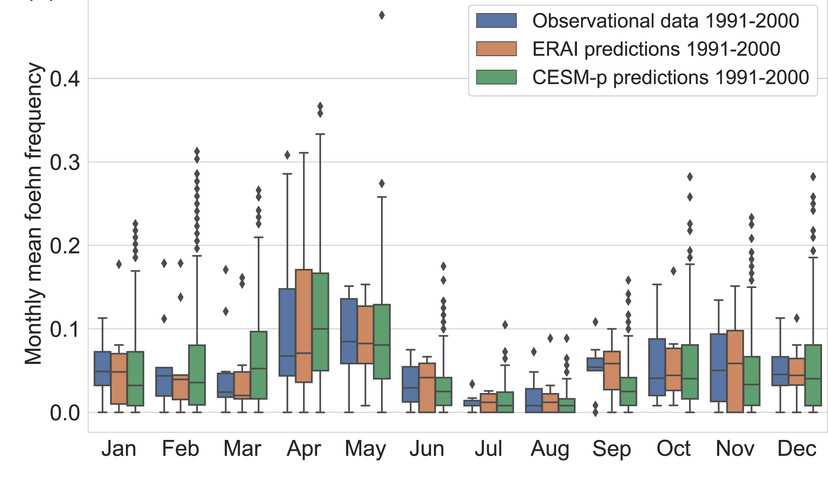
Foehn refers to a prominent orographic wind phenomena that can lead to stormy warm and dry conditions, which can also enhance forest fires. This study explores the possibilities of employing machine learning algorithms to predict foehn occurrence in Switzerland at a north Alpine (Altdorf) and south Alpine (Lugano) station from its synoptic fingerprint in reanalysis data and climate simulations. Atmospheric fields from ERA-Interim were used to train an XGBoost model, which is shown to be capable of accurately diagnosing foehn from the coarse synoptic situation (see figure). The algorithm was then generalized to predict foehn based on present-day and end-of-century simulations with CESM1-LENS. The results indicate that south foehn in Altdorf is expected to become more common during spring, while north foehn in Lugano is expected to become more common during summer.
Mony, C., L. Jansing, and M. Sprenger, 2021. Evaluating foehn occurrence in a changing climate based on reanalysis and climate model data using machine learning. Wea. Forecasting, 36, 2039–2055, external pagedoi:10.1175/WAF-D-21-0036.1call_made


